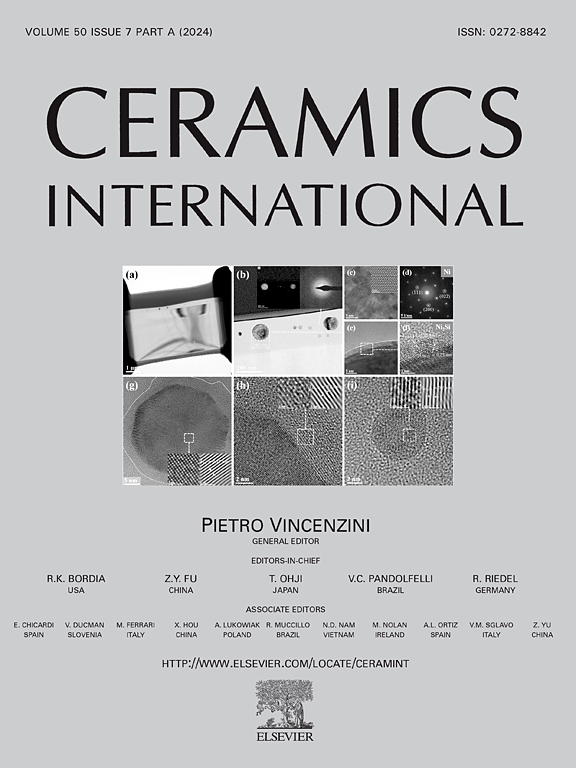溶胶-凝胶法合成p型Ca2+ +双铁氧体的气敏和光催化应用
IF 5.6
2区 材料科学
Q1 MATERIALS SCIENCE, CERAMICS
引用次数: 0
摘要
本文报道了纯铋铁氧体和掺钙铋铁氧体(BiFeO3)的溶胶-凝胶合成和表征,用于H2S气敏和Cr (VI)污染物还原。x射线衍射证实合成的铁氧体沿RC3空间群呈菱形结构。拉曼分析和EDX光谱证实了Ca2+离子在主晶格中的协同作用。随着Ca2+掺杂浓度的增加,光学带隙收缩。记录的对还原性气体(H2S)的灵敏度从纯BiFeO3的~ 4.5增加到18% Ca2+掺杂BiFeO3的~ 226。在5 ppm ~ 25 ppm的H2S环境中,18% Ca2+掺杂BiFeO3的响应时间保持非常快的1 ~ 2 s。气体响应曲线表现出铁氧体的p型行为,这种快速和改进的响应时间在p型半导体中还没有报道。在可见光照射下,以35W氙气弧光灯作为可见光光源,记录了Cr (VI)染料的降解情况。Cr (VI)的光降解率从纯BiFeO3的58%提高到18% Ca2+掺杂BiFeO3的90%。18% Ca2+掺杂BiFeO3的光稳定性很好,因为在20个循环中Cr (VI)的还原率高达64%。Ca2+取代Bi3+导致氧空位和Fe3+价势的数量显著改变,18% Ca2+掺杂BiFeO3显示出铁(IV)高量态(Fe4+),价带为2.47 eV,导带为0.61 eV。这些发现表明,18%二价(Ca2+)掺杂的BiFeO3是H2S气体传感和光催化应用的优秀候选者。本文章由计算机程序翻译,如有差异,请以英文原文为准。
Sol-gel synthesis of efficient p-type Ca2+@Bi-ferrites for gas sensing and photocatalytic applications
Herein, we report the sol-gel synthesis and characterizations of pure and Calcium (Ca) doped Bismuth ferrites (BiFeO3) for H2S gas sensing and Cr (VI) pollutant reduction. X-ray diffraction confirmed the rhombohedral structure along the RC3 space group of synthesized ferrites. Raman analysis and EDX spectroscopy confirmed the cooperation of Ca2+ ions in the host lattice. Contraction in optical bandgap was observed with increasing concentration of Ca2+ dopants. Sensitivity towards the reducing gas (H2S) recorded increased from ∼4.5 for pure BiFeO3 to ∼ 226 for 18 % Ca2+ doped BiFeO3. The response time of 18 % Ca2+ doped BiFeO3 remained very fast 1–2 s in 5 ppm–25 ppm exposure of H2S gas. The gas-responsive curves exhibited the p-type behavior of ferrites and such fast and improved response time was not reported in p-type semiconductors. Furthermore, the Cr (VI) dye degradation was recorded under the illumination of visible light and the 35W Xe arc lamp is taken as the source of visible light. The photodegradation of Cr (VI) improves significantly from 58 % for pure BiFeO3 to 90 % for 18 % Ca2+ doped BiFeO3. The photostability of 18 % Ca2+ doped BiFeO3 is well because the reduction of Cr (VI) recorded up to ∼64 % for 20 cycles. Substitution of Bi3+ with Ca2+ causes the oxygen vacancies and the amount of Fe3+ valance potentials altered significantly as well as 18 % Ca2+ doped BiFeO3 illustrated the iron (IV) higher amount state (Fe4+) with valence band at 2.47 eV and conduction band at 0.61 eV vs. normal hydrogen electrode. These findings depict that the 18 % divalent (Ca2+) doped BiFeO3 is an excellent candidate for H2S gas sensing and photocatalytic applications.
求助全文
通过发布文献求助,成功后即可免费获取论文全文。
去求助
来源期刊

Ceramics International
工程技术-材料科学:硅酸盐
CiteScore
9.40
自引率
15.40%
发文量
4558
审稿时长
25 days
期刊介绍:
Ceramics International covers the science of advanced ceramic materials. The journal encourages contributions that demonstrate how an understanding of the basic chemical and physical phenomena may direct materials design and stimulate ideas for new or improved processing techniques, in order to obtain materials with desired structural features and properties.
Ceramics International covers oxide and non-oxide ceramics, functional glasses, glass ceramics, amorphous inorganic non-metallic materials (and their combinations with metal and organic materials), in the form of particulates, dense or porous bodies, thin/thick films and laminated, graded and composite structures. Process related topics such as ceramic-ceramic joints or joining ceramics with dissimilar materials, as well as surface finishing and conditioning are also covered. Besides traditional processing techniques, manufacturing routes of interest include innovative procedures benefiting from externally applied stresses, electromagnetic fields and energetic beams, as well as top-down and self-assembly nanotechnology approaches. In addition, the journal welcomes submissions on bio-inspired and bio-enabled materials designs, experimentally validated multi scale modelling and simulation for materials design, and the use of the most advanced chemical and physical characterization techniques of structure, properties and behaviour.
Technologically relevant low-dimensional systems are a particular focus of Ceramics International. These include 0, 1 and 2-D nanomaterials (also covering CNTs, graphene and related materials, and diamond-like carbons), their nanocomposites, as well as nano-hybrids and hierarchical multifunctional nanostructures that might integrate molecular, biological and electronic components.
 求助内容:
求助内容: 应助结果提醒方式:
应助结果提醒方式:


